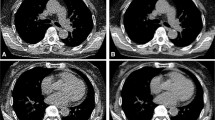Abstract
Purpose
Low-dose CT screening of the lungs is becoming a reality, triggering many more CT-guided lung biopsies. During these biopsies, the patient is submitted to repeated guiding scans with substantial cumulated radiation dose. Extension of the dose reduction to the biopsy procedure is therefore necessary. We propose an image denoising algorithm that specifically addresses the setup of CT-guided lung biopsies. It minimizes radiation exposure while keeping the image quality appropriate for navigation to the target lesion.
Methods
A database of high-SNR CT patches is used to filter noisy pixels in a non-local means framework, while explicitly enforcing local spatial consistency in order to preserve fine image details and structures. The patch database may be created from a multi-patient set of high-SNR lung scans. Alternatively, the first scan, acquired at high-SNR right before the needle insertion, can provide a convenient patient-specific patch database.
Results
The proposed algorithm is compared to state-of-the-art denoising algorithms for a dataset of 43 real CT-guided biopsy scans. Ultra-low-dose scans were simulated by synthetic noise addition to the sinogram, equivalent to a 96% reduction in radiation dose. The feature similarity score for the proposed algorithm outperformed the compared methods for all the scans in the dataset. The benefit of the patient-specific patch database over the multi-patient one is demonstrated in terms of recovered contrast for a tiny porcine lung nodule, following denoising with both approaches.
Conclusions
The proposed method provides a promising approach to the denoising of ultra-low-dose CT-guided biopsy images.











Similar content being viewed by others
References
Tsai I-C, Tsai W-L, Chen M-C, Chang G-C, Tzeng W-S, Chan S-W, Chen CC-C (2009) CT-guided core biopsy of lung lesions: a primer. Am J Roentgenol 193(5):1228–1235
RSNA (2016) Needle biopsy of the lung. http://www.radiologyinfo.org/en/info.cfm?pg=nlungbiop
Wagnetz U, Menezes RJ, Boerner S, Paul NS, Wagnetz D, Keshavjee S, Roberts HC (2012) CT screening for lung cancer: implication of lung biopsy recommendations. Am J Roentgenol 198(2):351–358
Lamba R (2014) Radiation dose optimization for CT-guided interventional procedures in the abdomen and pelvis. J Am Coll Radiol 11(3):279–284
Shepherd T, Hess C, Chin C, Gould R, Dillon W (2011) Reducing patient radiation dose during CT-guided procedures: demonstration in spinal injections for pain. Am J Neuroradiol 32(10):1776–1782
Patel AS, Soares B, Courtier J, MacKenzie JD (2013) Radiation dose reduction in pediatric CT-guided musculoskeletal procedures. Pediatric Radiol 43(10):1303–1308
Kloeckner R, dos Santos DP, Schneider J, Kara L, Dueber C, Pitton MB (2013) Radiation exposure in CT-guided interventions. Eur J Radiol 82(12):2253–2257
Smith JC, Jin DH, Watkins GE, Miller TR, Karst JG, Oyoyo UE (2011) Ultra-low-dose protocol for CT-guided lung biopsies. J Vasc Interv Radiol 22(4):431–436
Meng X-X, Kuai X-P, Dong W-H, Jia N-Y, Liu S-Y, Xiao X-S (2013) Comparison of lung lesion biopsies between low-dose CT-guided and conventional CT-guided techniques. Acta Radiol 54(8):909–915
Yu H, Zhao S, Hoffman EA, Wang G (2009) Ultra-low dose lung CT perfusion regularized by a previous scan. Acad Radiol 16(3):363–373
Hashemi S, Paul NS, Beheshti S, Cobbold RS (2015) Adaptively tuned iterative low dose CT image denoising. Comput Math Methods Med 2015(9):1–12. doi:10.1155/2015/638568
Chen H, Zhang Y, Zhang W, Liao P, Li K, Zhou J, Wang G (2016) Low-dose CT denoising with convolutional neural network. arXiv preprint, arXiv:1610.00321
Ha S, Mueller K (2015) Low dose CT image restoration using a database of image patches. Phys Med Biol 60(2):869
Green M, Marom EM, Kiryati N, Konen E, Mayer A (2016) Efficient low-dose CT denoising by locally-consistent non-local means (LC-NLM). In: International conference on medical image computing and computer-assisted intervention. Springer
Dabov K, Foi A, Katkovnik V, Egiazarian K (2007) Image denoising by sparse 3-D transform-domain collaborative filtering. Image Process IEEE Trans 16(8):2080–2095
Zoran D, Weiss Y (2011) From learning models of natural image patches to whole image restoration. In: 2011 international conference on computer vision, IEEE
Chen F, Zhang L, Yu H, (2015) External patch prior guided internal clustering for image denoising. In: Proceedings of the IEEE international conference on computer vision
Buades A, Coll B, Morel JM (2005) A non-local algorithm for image denoising. In: Proceedings of Computer vision and pattern recognition. CVPR 2005. IEEE computer society conference on 2005, IEEE
Goldberg DE (1989) Genetic algorithms in search optimization and machine learning, vol 412. Addison-Wesley, Menlo Park
Silpa-Anan C, Hartley R (2008) Optimised KD-trees for fast image descriptor matching. In: Proceedings of IEEE Conference on computer vision and pattern recognition, 2008. CVPR 2008, IEEE
Muja M, Lowe DG (2009) Fast approximate nearest neighbors with automatic algorithm configuration. VISAPP (1), 2(331–340), 2
Zhang L, Zhang L, Mou X, Zhang D (2011) FSIM: a feature similarity index for image quality assessment. IEEE Trans Image Process 20(8):2378–2386
Morrone MC, Burr D (1988) Feature detection in human vision: a phase-dependent energy model. Proc R Soc Lond B Biol Sci 235(1280):221–245
Morrone MC, Ross J, Burr DC, Owens R (1986) Mach bands are phase dependent. Nature 324(6094):250–253
McNitt-Gray MF (2002) AAPM/RSNA physics tutorial for residents: topics in CT: radiation dose in CT 1. Radiographics 22(6):1541–1553
Lebrun M (2012) An analysis and implementation of the BM3D image denoising method. Image Process Line 2:175–213
Michelson AA (1995) Studies in optics. Courier Corporation, Massachusetts
Author information
Authors and Affiliations
Corresponding author
Ethics declarations
Conflict of interest
The authors declare that they have no conflict of interest.
Ethical standard
All procedures performed in studies involving human participants were in accordance with the ethical standards of the institutional and/or national research committee and with the 1964 Helsinki Declaration and its later amendments or comparable ethical standards.
Informed consent
For this type of study, formal consent is not required.
Rights and permissions
About this article
Cite this article
Green, M., Marom, E.M., Konen, E. et al. Patient-specific image denoising for ultra-low-dose CT-guided lung biopsies. Int J CARS 12, 2145–2155 (2017). https://doi.org/10.1007/s11548-017-1621-6
Received:
Accepted:
Published:
Issue Date:
DOI: https://doi.org/10.1007/s11548-017-1621-6




